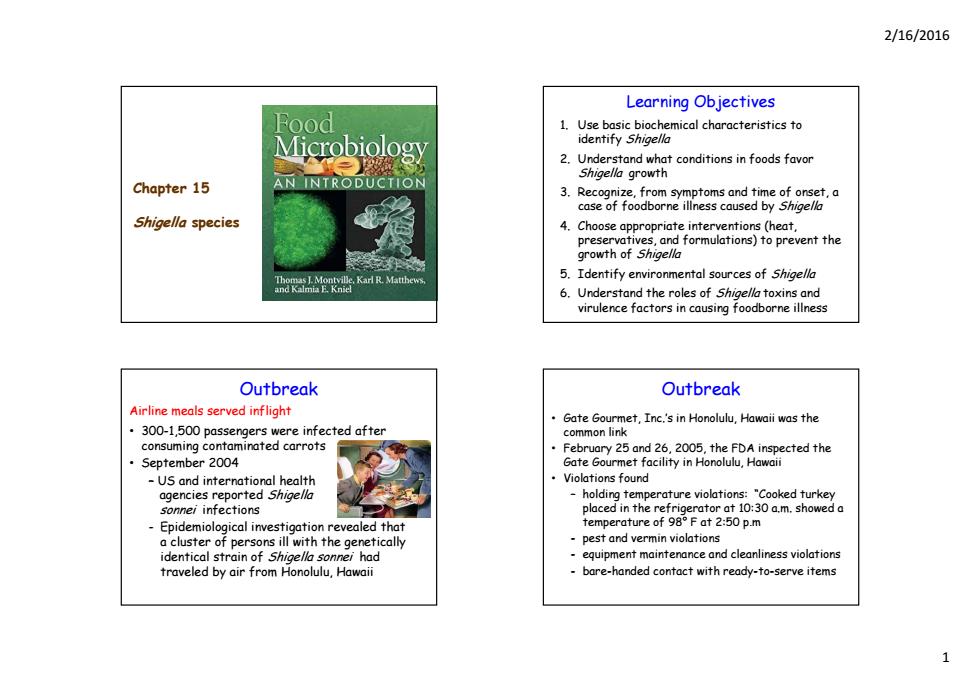
2/16/2016 Learning Objectives Food 1.Use basic biochemical characteristics to identify Shigella 2.Understand what conditions in foods favor Shigella growth Chapter15 AN INTRODUCTION 3.Recognize,from symptoms and time of onset,a case of foodborne illness caused by Shigell Shigella species 4.Choose appropriate interventions (heat, preservatives,and formulations)to prevent the growth of Shigella 5.Identify environmental sources of Shigella 6.Understand the roles of Shigella toxins and virulence factors in causing foodborne illness Outbreak Outbreak Airline meals served inflight Gate Gourmet,Inc.'s in Honolulu,Hawaii was the 300-1,500 passengers were infected after common link consuming contaminated carrots February 25 and 26,2005,the FDA inspected the September 2004 Gate Gourmet facility in Honolulu,Hawaii -US and international health ·.Violations found agencies reported Shigella holding temperature violations:"Cooked turkey sonnei infections placed in the refrigerator at 10:30 a.m.showed a Epidemiological investigation revealed that temperature of 98F at 2:50 p.m a cluster of persons ill with the genetically pest and vermin violations identical strain of Shigella sonnei had equipment maintenance and cleanliness violations traveled by air from Honolulu,Hawaii bare-handed contact with ready-to-serve items
2/16/2016 1 Chapter 15 Shigella species Learning Objectives 1. Use basic biochemical characteristics to identify Shigella 2. Understand what conditions in foods favor Shigella growth 3. Recognize, from symptoms and time of onset, a case of foodborne illness caused by Shigella 4. Choose appropriate interventions (heat, preservatives, and formulations) to prevent the growth of Shigella 5. Identify environmental sources of Shigella 6. Understand the roles of Shigella toxins and virulence factors in causing foodborne illness Outbreak Airline meals served inflight • 300-1,500 passengers were infected after consuming contaminated carrots • September 2004 – US and international health agencies reported Shigella sonnei infections - Epidemiological investigation revealed that a cluster of persons ill with the genetically identical strain of Shigella sonnei had traveled by air from Honolulu, Hawaii Outbreak • Gate Gourmet, Inc.’s in Honolulu, Hawaii was the common link • February 25 and 26 2005 the FDA inspected the February 25 and 26, 2005, the FDA inspected the Gate Gourmet facility in Honolulu, Hawaii • Violations found – holding temperature violations: “Cooked turkey placed in the refrigerator at 10:30 a.m. showed a temp f erature of 98° F at 2:50 p.m - pest and vermin violations - equipment maintenance and cleanliness violations - bare-handed contact with ready-to-serve items
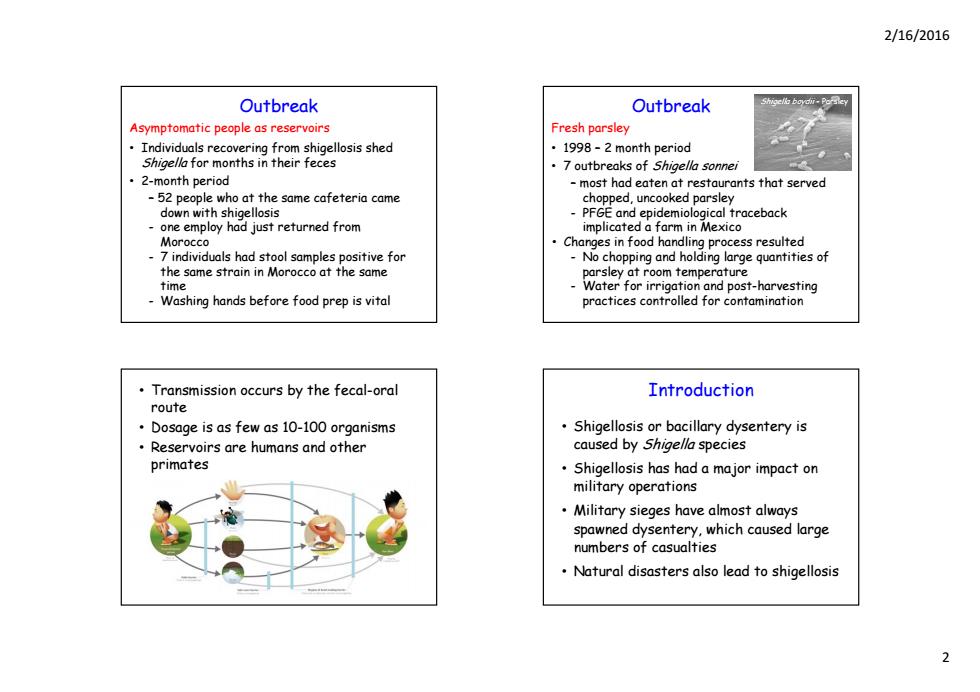
2/16/2016 Outbreak Outbreak boydir-Parsley Asymptomatic people as reservoirs Fresh parsley Individuals recovering from shigellosis shed 1998-2 month period Shigella for months in their feces 7 outbreaks of Shigella sonnei ·2-month period most had eaten at restaurants that served -52 people who at the same cafeteria came chopped,uncooked parsley down with shigellosis PFGE and epidemiological traceback one employ had just returned from implicated a farm in Mexico Morocco .Changes in food handling process resulted -7 individuals had stool samples positive for -No chopping and holding large quantities of the same strain in Morocco at the same parsley at room temperature time Water for irrigation and post-harvesting Washing hands before food prep is vital practices controlled for contamination Transmission occurs by the fecal-oral Introduction route Dosage is as few as 10-100 organisms Shigellosis or bacillary dysentery is Reservoirs are humans and other caused by Shigella species primates Shigellosis has had a major impact on military operations Military sieges have almost always spawned dysentery,which caused large numbers of casualties Natural disasters also lead to shigellosis
2/16/2016 2 Outbreak Asymptomatic people as reservoirs • Individuals recovering from shigellosis shed Shigella for months in their feces • 2-month period – 52 people who at the same cafeteria came down with shigellosis - one employ had just returned from Morocco - 7 individuals had stool samples positive for the same strain in Morocco at the same time - Washing hands before food prep is vital Outbreak Fresh parsley • 1998 – 2 month period • 7 outbreaks of Shigella sonnei Shigella boydii - Parsley • 7 outbreaks of Shigella sonnei – most had eaten at restaurants that served chopped, uncooked parsley - PFGE and epidemiological traceback implicated a farm in Mexico • Changes in food handling process resulted - No chopping and holding large quantities of parsley at room temperature - Water for irrigation and post-harvesting practices controlled for contamination • Transmission occurs by the fecal-oral route • Dosage is as few as 10-100 organisms • Reservoirs are humans and other primates • Shigellosis or bacillary dysentery is caused by Shigella species Introduction • Shigellosis has had a major impact on military operations • Military sieges have almost always sp n d d s nt r hich c us d l r spawned dysentery, which caused large numbers of casualties • Natural disasters also lead to shigellosis
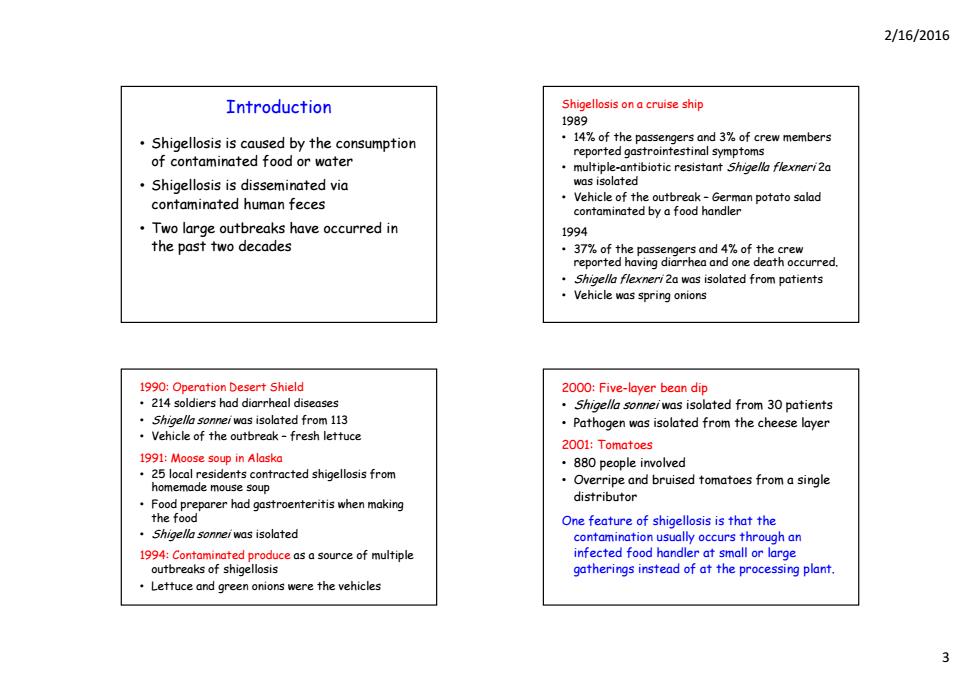
2/16/2016 Introduction Shigellosis on a cruise ship 1989 Shigellosis is caused by the consumption 14%of the passengers and 3%of crew members of contaminated food or water reported gastrointestinal symptoms multiple-antibiotic resistant Shigella flexneri2a Shigellosis is disseminated via was isolated contaminated human feces Vehicle of the outbreak-German potato salad contaminated by a food handler Two large outbreaks have occurred in 1994 the past two decades 37%of the passengers and 4%of the crew reported having diarrhea and one death occurred. Shigella flexneri2a was isolated from patients Vehicle was spring onions 1990:Operation Desert Shield 2000:Five-layer bean dip 214 soldiers had diarrheal diseases Shigella sonneiwas isolated from 30 patients Shigella sonneiwas isolated from 113 Pathogen was isolated from the cheese layer Vehicle of the outbreak-fresh lettuce 2001:Tomatoes 1991:Moose soup in Alaska ·88 0 people involved 25 local residents contracted shigellosis from homemade mouse soup Overripe and bruised tomatoes from a single distributor One feature of shigellosis is that the Shigella sonnei was isolated contamination usually occurs through an 1994:Contaminated produce as a source of multiple infected food handler at small or large outbreaks of shigellosis gatherings instead of at the processing plant Lettuce and green onions were the vehicles
2/16/2016 3 • Shigellosis is caused by the consumption of contaminated food or water Introduction • Shigellosis is disseminated via contaminated human feces • Two large outbreaks have occurred in th p st t d c d s th e p ast two d e c a d e s Shigellosis on a cruise ship 1989 • 14% of the passengers and 3% of crew members reported gastrointestinal symptoms • m ltipl multiple-antibi ti sist nt ntibiotic resist ant Shi ll gea fl xn i flexneri 2 a was isolated • Vehicle of the outbreak – German potato salad contaminated by a food handler 1994 • 37% f h d 4% f h % of the passengers and 4% of the crew reported having diarrhea and one death occurred. • Shigella flexneri 2a was isolated from patients • Vehicle was spring onions 1990: Operation Desert Shield • 214 soldiers had diarrheal diseases • Shigella sonnei was isolated from 113 • Vehicle of the outbreak – fresh lettuce 1991: Moose soup in Alaska • 25 local residents contracted shigellosis from homemade mouse soup • Food preparer had gastroenteritis when making the food • Shigella sonnei was isolated 1994: Contaminated produce as a source of multiple outbreaks of shigellosis • Lettuce and green onions were the vehicles 2000: Five-layer bean dip • Shigella sonnei was isolated from 30 patients • Pathogen was isolated from the cheese layer 2001: Tomatoes • 880 people involved • Overripe and bruised tomatoes from a single distributor One feature of shi gellosis is that the contamination usually occurs through an infected food handler at small or large gatherings instead of at the processing plant
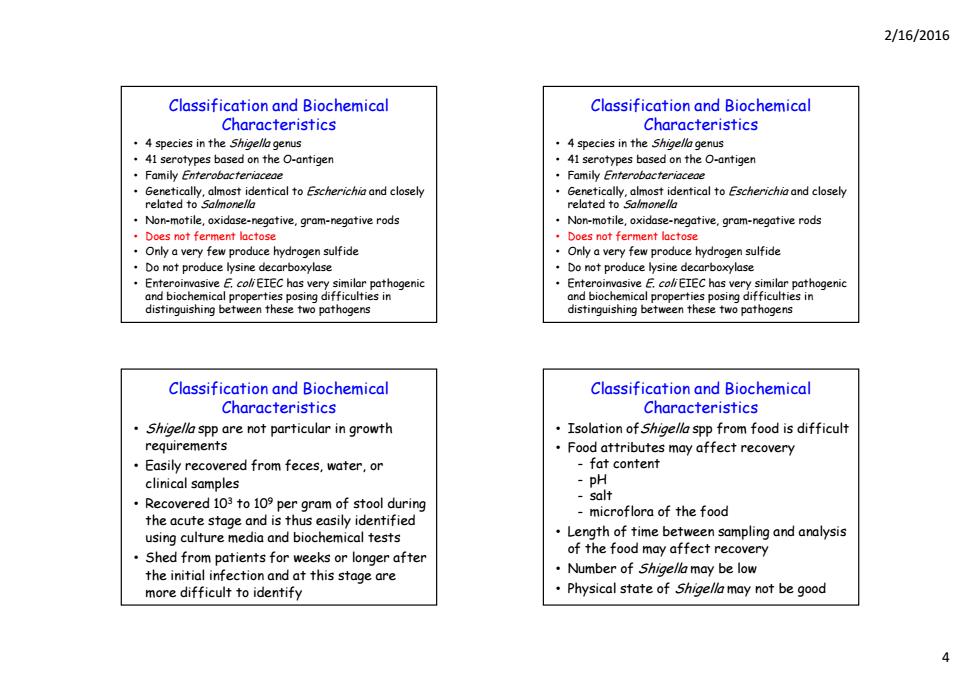
2/16/2016 Classification and Biochemical Classification and Biochemical Characteristics Characteristics 4 species in the Shigella genus 4 species in the Shigella genus 41 serotypes based on the O-antigen 41 serotypes based on the O-antigen Family Enterobacteriaceae Family Enterobacteriacede Genetically,almost identical to Escherichia and closely Genetically,almost identical to Escherichia and closely related to Salmonella related to Salmonella Non-motile,oxidase-negative,gram-negative rods Non-motile,oxidase-negative,gram-negative rods Does not ferment lactose Does not ferment lactose Only a very few produce hydrogen sulfide Only a very few produce hydrogen sulfide Do not produce lysine decarboxylase Do not produce lysine decarboxylase distinguishing between these two pathogens distinguishing between these two pathogens Classification and Biochemical Classification and Biochemical Characteristics Characteristics Shigella spp are not particular in growth Isolation of Shigella spp from food is difficult requirements Food attributes may affect recovery Easily recovered from feces,water,or fat content clinical samples pH Recovered 103to 109 per gram of stool during salt microflora of the food the acute stage and is thus easily identified using culture media and biochemical tests Length of time between sampling and analysis Shed from patients for weeks or longer after of the food may affect recovery the initial infection and at this stage are Number of Shigella may be low more difficult to identify Physical state of Shigella may not be good
2/16/2016 4 Classification and Biochemical Characteristics • 4 species in the Shigella genus • 41 serotypes based on the O-antigen • Family Enterobacteriaceae • Genetically, almost identical to Escherichia and closely related to Salmonella • Non-motile, oxidase-negative, gram-negative rods • Does not ferment lactose • Only a very few produce hydrogen sulfide • Do not produce lysine decarboxylase • Enteroinvasive E. coli EIEC has very similar pathogenic and biochemical properties posing difficulties in distinguishing between these two pathogens Classification and Biochemical Characteristics • 4 species in the Shigella genus • 41 serotypes based on the O-antigen • Family Enterobacteriaceae • Genetically, almost identical to Escherichia and closely related to Salmonella • Non-motile, oxidase-negative, gram-negative rods • Does not ferment lactose • Only a very few produce hydrogen sulfide • Do not produce lysine decarboxylase • Enteroinvasive E. coli EIEC has very similar pathogenic and biochemical properties posing difficulties in distinguishing between these two pathogens Classification and Biochemical Characteristics • Shigella spp are not particular in growth requirements • Easily recovered from feces, water, or clinical samples • Recovered 103 to 109 per gram of stool during the acute stag y e and is thus easily identified using culture media and biochemical tests • Shed from patients for weeks or longer after the initial infection and at this stage are more difficult to identify Classification and Biochemical Characteristics • Isolation ofShigella spp from food is difficult • Food attributes may affect recovery - fat content - pH - salt - microflora of the food • L h f i b li d l i Length of time between sampling and analysis of the food may affect recovery • Number of Shigella may be low • Physical state of Shigella may not be good
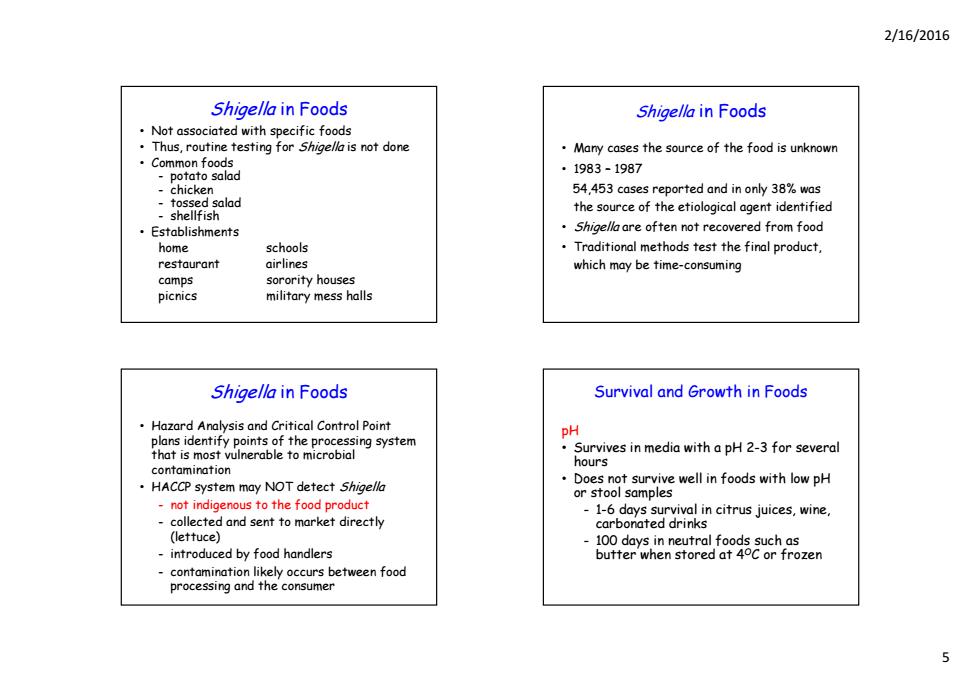
2/16/2016 Shigella in Foods Shigella in Foods Not associated with specific foods .Thus,routine testing for Shigella is not done Many cases the source of the food is unknown ·Common foods potato salad ·1983-1987 -chicken 54,453 cases reported and in only 38%was -tossed salad -shellfish the source of the etiological agent identified Establishments Shigella are often not recovered from food home schools Traditional methods test the final product, restaurant airlines which may be time-consuming camps sorority houses picnics military mess halls Shigella in Foods Survival and Growth in Foods Hazard Analysis and Critical Control Point pH plans identify points of the processing system that is most vulnerable to microbial Survives in media with a pH 2-3 for several hours contamination HACCP system may NOT detect Shigella Does not survive well in foods with low pH or stool samples not indigenous to the food product -1-6 days survival in citrus juices,wine collected and sent to market directly carbonated drinks (lettuce) 100 days in neutral foods such as introduced by food handlers butter when stored at 40C or frozen -contamination likely occurs between food processing and the consumer
2/16/2016 5 Shigella in Foods • Not associated with specific foods • Thus, routine testing for Shigella is not done • Common foods - potato salad - chicken - tossed salad - shellfish • Establishments home sch l oo s restaurant airlines camps sorority houses picnics military mess halls Shigella in Foods • Many cases the source of the food is unknown • 1983 – 1987 54,453 cases reported and in only 38% was the source of the etiological agent identified • Shigella are often not recovered from food • T diti l th d t t th fi l d t Traditional meth o ds test th e final pro duct, which may be time-consuming Shigella in Foods • Hazard Analysis and Critical Control Point p yp p g y lans identif y points of the processin g s ystem that is most vulnerable to microbial contamination • HACCP system may NOT detect Shigella - not indigenous to the food product - collected a nnm y d se nt to market directl y (lettuce) - introduced by food handlers - contamination likely occurs between food processing and the consumer Survival and Growth in Foods pH • Survives in media with a pH 2-3 for several hours • Does not survive well in foods with low pH or stool samples - 1-6 days survival in citrus juices, wine, carbonated drinks - 100 days in neutral foods such as butter when stored at 4 OC or frozen
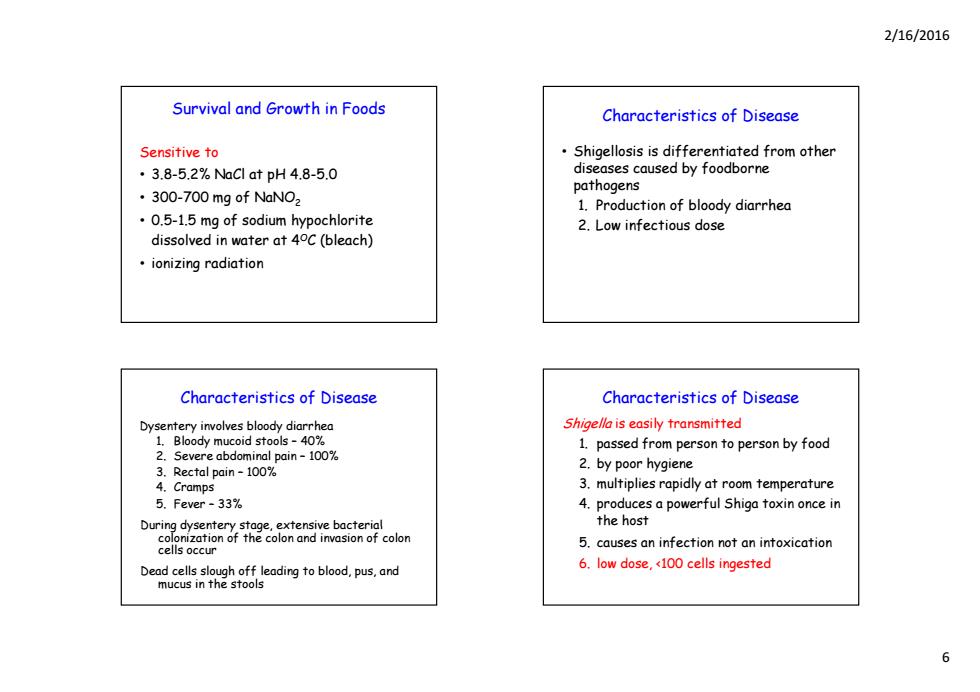
2/16/2016 Survival and Growth in Foods Characteristics of Disease Sensitive to Shigellosis is differentiated from other ·3.8-5.2%NaC1atpH4.8-5.0 diseases caused by foodborne pathogens ·300-700 mg of NaN02 1.Production of bloody diarrhea 0.5-1.5 mg of sodium hypochlorite 2.Low infectious dose dissolved in water at 40C (bleach) ·ionizing radiation Characteristics of Disease Characteristics of Disease Dysentery involves bloody diarrhea Shigella is easily transmitted 1.Bloody mucoid stools-40% 1.passed from person to person by food 2.Severe abdominal pain-100% 3.Rectal pain -100% 2.by poor hygiene 4.Cramps 3.multiplies rapidly at room temperature 5.Fever-33% 4.produces a powerful Shiga toxin once in During dysentery stage,extensive bacterial the host colonization of the colon and invasion of colon cells occur 5.causes an infection not an intoxication Dead cells slough off leading to blood,pus,and 6.low dose,100 cells ingested mucus in the stools 6
2/16/2016 6 Survival and Growth in Foods Sensitive to • 3.8-5.2% NaCl at pH 4.8-5.0 • 300-700 mg of NaNO2 • 0.5-1.5 mg of sodium hypochlorite dissolved in water at 4OC (bleach) • ionizing radiation Characteristics of Disease • Shigellosis is differentiated from other di d b f db diseases caused by foodborne pathogens 1. Production of bloody diarrhea 2. Low infectious dose Characteristics of Disease Dysentery involves bloody diarrhea 1. Bloody mucoid stools – 40% 2. Severe abdominal pain – 100% 3. Rectal pain – 100% 4. Cramps 5. Fever – 33% During dysentery stage extensive bacterial During dysentery stage, extensive bacterial colonization of the colon and invasion of colon cells occur Dead cells slough off leading to blood, pus, and mucus in the stools Characteristics of Disease Shigella is easily transmitted 1. passed from person to person by food 2. by poor hygiene 3. multiplies rapidly at room temperature 4. produces a powerful Shiga toxin once in the host 5. causes an infection not an intoxication 6. low dose, <100 cells ingested
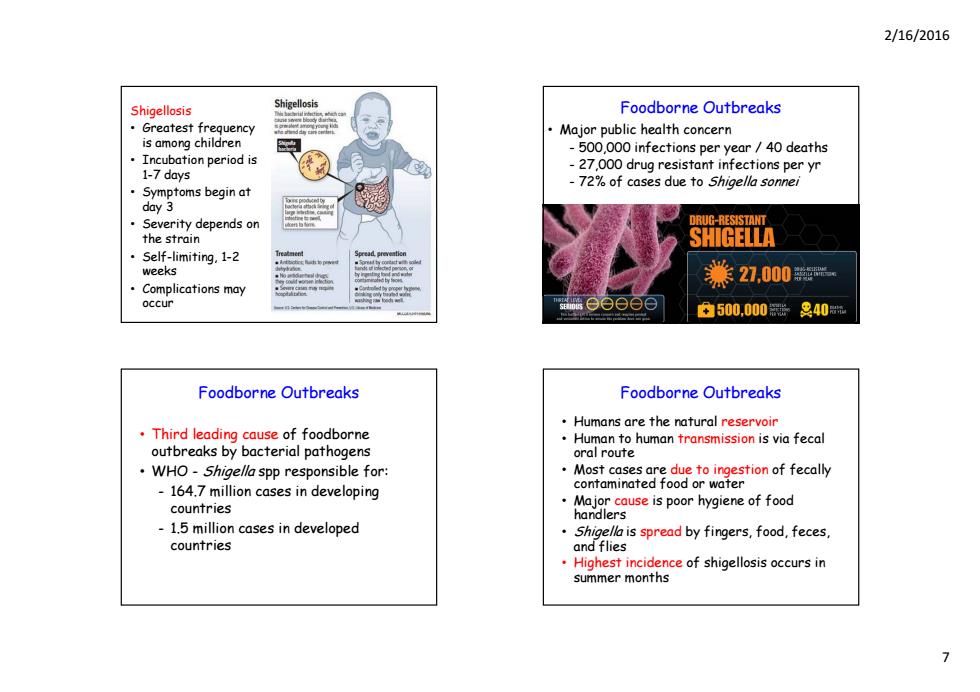
2/16/2016 Shigellosis Shigellosis Foodborne Outbreaks ·Greatest frequency Major public health concern is among children Incubation period is -500.000 infections per year/40 deaths 1-7 days -27.000 drug resistant infections per yr -72%of cases due to Shigella sonnei ·Symptoms begin at day 3 ·Severity depends on DRUG-RESISTANT the strain SHIGELLA Self-limiting,1-2 weeks 米27.000= ·Complications may occur 中500,000器黑40元 Foodborne Outbreaks Foodborne Outbreaks Humans are the natural reservoir Third leading cause of foodborne Human to human transmission is via fecal outbreaks by bacterial pathogens oral route WHO-Shigella spp responsible for: Most cases are due to ingestion of fecally -164.7 million cases in developing contaminated food or water countries Major cause is poor hygiene of food handlers -1.5 million cases in developed Shigella is spread by fingers,food,feces, countries and flies Highest incidence of shigellosis occurs in summer months
2/16/2016 7 Shigellosis • Greatest frequency is among children • Incubation period is 1-7 days • Symptoms begin at day 3 • Severity depends on the strain • Self-limiting, 1-2 weeks • Complications may occur Foodborne Outbreaks • Major public health concern - 500,000 infections per year / 40 deaths - 27 000 drug resistant infections per yr 27,000 drug resistant infections per yr - 72% of cases due to Shigella sonnei Foodborne Outbreaks • Third leading cause of foodborne outb k b b t i l th tbrea k s b y bac terial pathogens • WHO - Shigella spp responsible for: - 164.7 million cases in developing countries - 1 5 million cases in developed 1.5 million cases in developed countries Foodborne Outbreaks • Humans are the natural reservoir • Human to human transmission is via fecal oral route • Most cases are due to ingestion of fecally contaminated food or water • Major cause is poor hygiene of food handlers • Sh ll igea is sprea d b f f d f b y fingers, foo d, feces, and flies • Highest incidence of shigellosis occurs in summer months
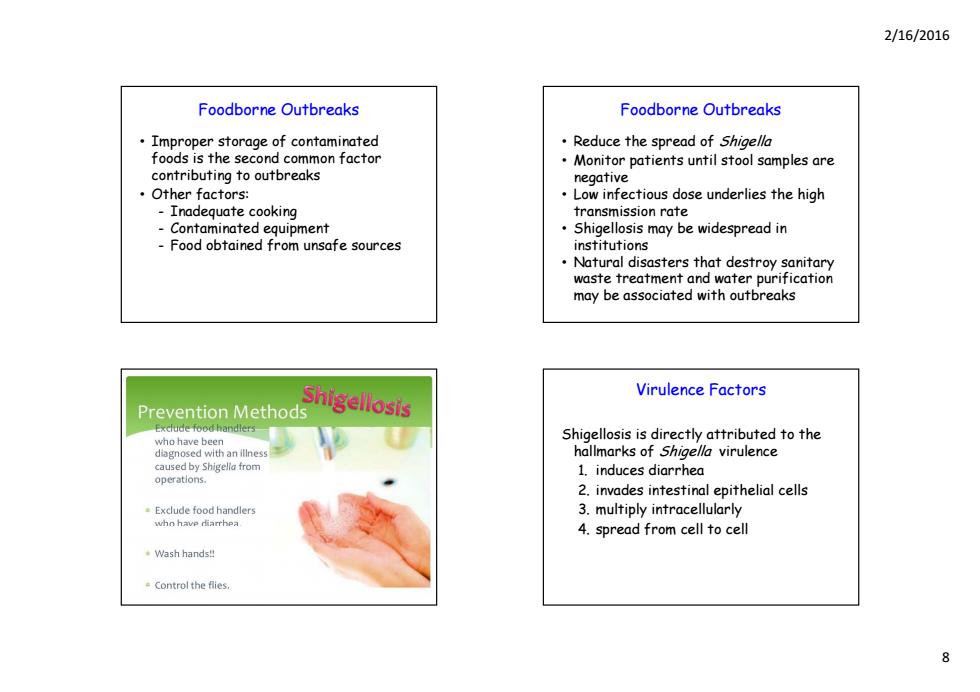
2/16/2016 Foodborne Outbreaks Foodborne Outbreaks Improper storage of contaminated Reduce the spread of Shigella foods is the second common factor Monitor patients until stool samples are contributing to outbreaks negative Other factors: Low infectious dose underlies the high -Inadequate cooking transmission rate Contaminated equipment Shigellosis may be widespread in -Food obtained from unsafe sources institutions Natural disasters that destroy sanitary waste treatment and water purification may be associated with outbreaks Prevention Methods Shigellosis Virulence Factors Exclude food handlers who have been Shigellosis is directly attributed to the diagnosed with an illness hallmarks of Shigella virulence caused by Shigella from 1.induces diarrhea operations. 2.invades intestinal epithelial cells .Exclude food handlers 3.multiply intracellularly who havp rarrhpa 4.spread from cell to cell .Wash hands!! Control the flies
2/16/2016 8 Foodborne Outbreaks • Improper storage of contaminated foods is the second common factor contributing to outbreaks • Other factors: - Inadequate cooking - Contaminated equipment - Food obtained from unsafe sources Foodborne Outbreaks • Reduce the spread of Shigella • Monitor patients until stool samples are negative • Low infectious dose underlies the high transmission rate • Shigellosis may be widespread in institutions • Natural disasters that destroy sanitary waste treatment and water purification may be associated with outbreaks Virulence Factors Shigellosis is directly attributed to the h ll k f hallmarks of Shi ll gea vi l ru ence 1. induces diarrhea 2. invades intestinal epithelial cells 3. multiply intracellularly 4. spread from cell to cell
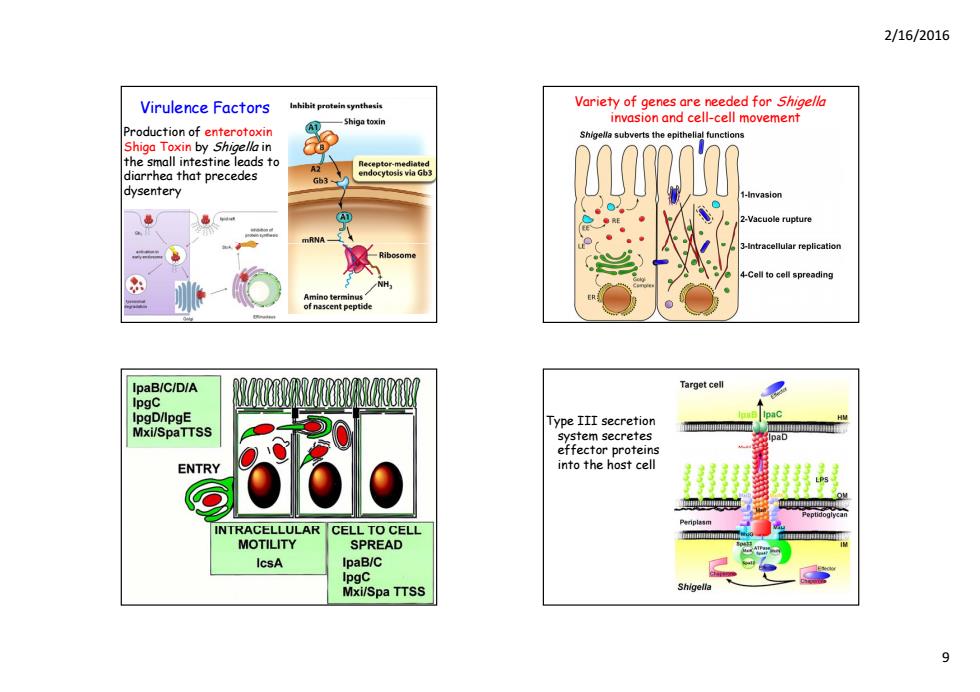
2/16/2016 Virulence Factors Variety of genes are needed for Shigella 一Shiga toxin invasion and cell-cell movement Production of enterotoxin subverts the epi functions Shiga Toxin by Shigella in the small intestine leads to diarrhea that precedes G63 dysentery cuole rupture mRNA- tracellular replication -Cell to cell spreading IpaB/C/D/A Target cell IpgD/lpgE Type III secretior Mxi/SpaTTSS system secretes effector proteins ENTRY into the host cell INTRACELLULAR CELL TO CELL MOTILITY SPREAD IcsA IpaB/C Ipgc Mxi/Spa TTSS
2/16/2016 9 Virulence Factors Production of enterotoxin Shiga Toxin by Shigella in the small intestine leads to diarrhea that precedes dysentery Variety of genes are needed for Shigella invasion and cell-cell movement Type III secretion system secretes eff t t i s ffector proteins into the host cell
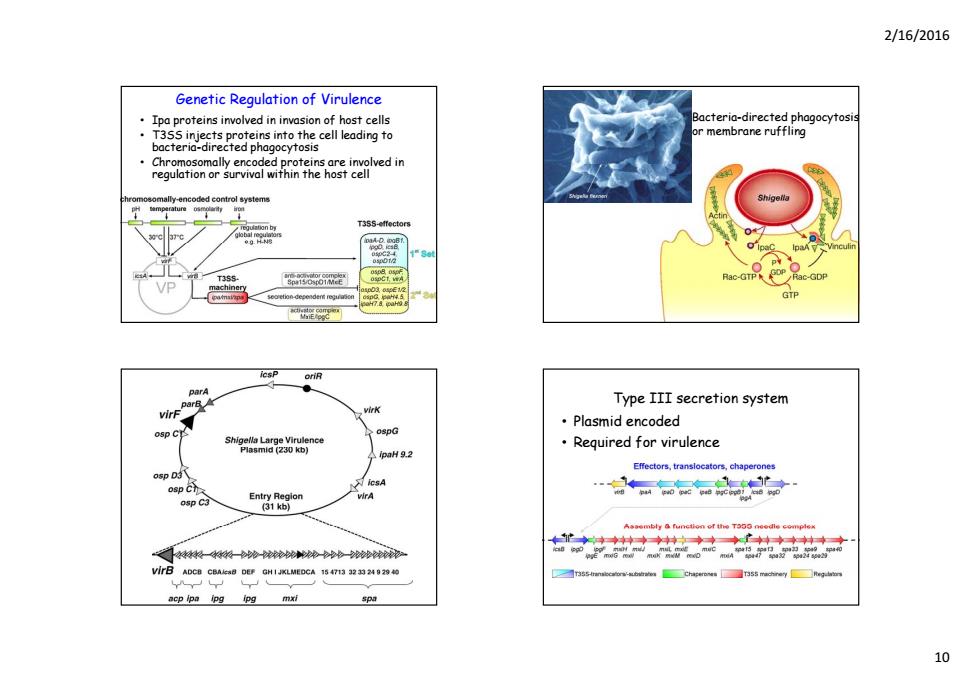
2/16/2016 Genetic Regulation of Virulence Ipa proteins involved in invasion of host cells acteria-directed phagocytos or membrane ruffling Chromosomally encoded proteins are involved in regulation or survival within the host cell T355-ffectors 0806E Rac-GTPG0 ac-GDP GTP oriR Type III secretion system ·Plasmid encoded osp C ospG Shig Required for virulence Effectors,translocators,chaperones osp D osp ch osp C3 Entry Region virA 31kb) Aasembly a function of the T09 nedie complex 轻一水6的浓3线轮p60响就 T3SS-irnsiccsors:-actrsos Chaperones T355 acp ipa ipg ipg mxi 10
2/16/2016 10 Genetic Regulation of Virulence • Ipa proteins involved in invasion of host cells • T3SS injects proteins into the cell leading to bacteria-directed phagocytosis • Chromosomally encoded proteins are involved in regulation or survival within the host cell Bacteria-directed phagocytosis or membrane ruffling Type III secretion system • Plasmid encoded • Req f uired for virulence